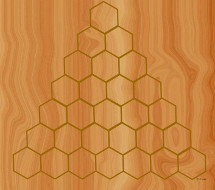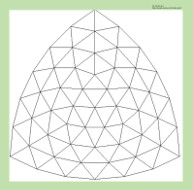Hex and Y
Written by Howard Fosdick © BestFreeNewGames.com
Overview: In connection games like Hex and Y, your goal is to connect the sides of the playing board by a contiguous string of your own markers.
Hex dates from the early 1940s, whence it was invented by Dane Piet Hein. Y followed on its heels a decade later. The difference between the two games is that in Hex you try to connect two sides of a rhombus with your pieces, while in Y, you must connect a path between three sides of a triangular board.
Hex Rules:
Both Hex and Y are played on boards of varying sizes. With Hex, the most common board is a 11 by 11 rhombus. 13 by 13 and 19 by 19 boards are also popular.

Players are assigned opposite sides of the board. The goal is for a player to connect his two opposite sides of the board with an unbroken line of his markers.
Players alternate turns. In his turn, a player places one of his markers on any unoccupied cell on the board. Markers are never moved or removed during the game; where they are placed is where they stay.
Note that the four corner positions count as belonging to both sides of the board to which they are adjacent.
Since going first confers a significant advantage in this game, most players use the pie rule. This says that whoever goes first places one stone on the board. Then the second player -- in his first turn only -- may either replace the leader's piece with one of his own, or he may accept it as valid and place his first marker anywhere else on the board.
This rule is called the pie rule because it's akin to the fairest way of dividing a pie. One person slices the pie in half, the other person gets to decide which piece to take. Applying this principle to Hex minimizes the advantage otherwise conferred on whoever takes the first turn in the game.
Some people refer to the pie rule as the swap rule, since the player who gets the second turn in the game has the option to swap for his opponent's first piece.
Y Rules:


Y boards come in two flavours. The first consists of hexagons, just like the game Hex. The difference is that the board comprises a three-sided triangle. Players must connect all three sides with a path of their pieces to win.
The second sort of Y board presents a curved triangle. As the illustration shows, it's sometimes referred to as the bent board. In this case, players place their pebbles on the intersections of the lines. The goal is still the same: connect all three sides with a single line of markers.
Y boards are identified by the number of piece positions per side. For example, a board that is 7 by 7 by 7 is just called a "size 7" board. The most popular sizes are probably 7, 8, and 9.
-----------------------------------
Tips for Play:
You'll notice that the size of board on which you play significantly alters the game. Smaller boards lend themselves more to tactical play, while larger boards require more strategic thinking.
Obviously, larger boards result in a more complex game simply because there are more positions to consider.
With Y, the board size typically affects play more than whether you use the hexagonal or bent designs. You will notice a few differences between the two designs. For example, the corner positions in the hexagonal board connect to two other cells, whereas the corner slots in the bent board link to three other positions.
-----------------------------------
Print Your Own Game Board:
If you'd like to print your own game board, we offer several different free images. Just
click here. You don't need to buy anything to play. You'll just need to add playing pieces from some other "pebble game", such as Go, Othello, or the like.
To print Hex and Y boards of any size: click here for Hex boards and click here for Y boards. These boards are unadorned. They appear as thin black lines on all-white backgrounds, and are open-sourced licensed for free download.
You can also buy beautiful finished wood boards such as this one from Kadon Enterprises:
-----------------------------------
Sources:
Many websites describe Hex and Y. If you get really absorbed in the game, you can google for in-depth strategies and even intense mathematical analyses.
Click here for more free games on this website.
-----------------------------------License: Feel free to print, copy, and distribute these rules, so long as you retain this paragraph. Written by Howard Fosdick © 2023, distributed under Creative Commons License BY-ND. HOME
